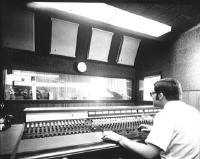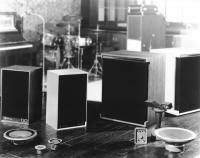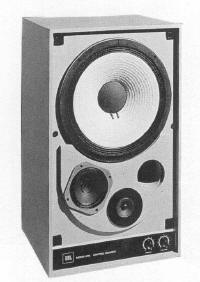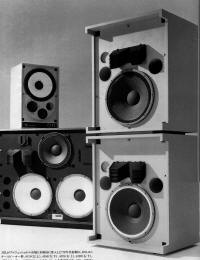|
|
Development of an Industry Standard - JBL 4310
|

1960's Era Control Room with JBL 4320's
© Harman International, Courtesy
Mark Gander and John Eargle
|
With the great success of the 4320 Studio Monitor in the
1960s, the JBL management began to explore ways in which they might extend
their offerings in this area. The increasing complexity of recording studio
mixing consoles resulted in ever-larger physical dimensions of the
electronic equipment. Effective installation of floor-standing monitor
loudspeakers was not always possible or even desirable, due to the inability
to locate the audio engineer beyond the near-field effect of the
reproducers. What the industry needed was a compact system that could be
placed either on the console bridge, control room window shelf, or suspended
from the ceiling. This would leave the larger 4320 available for even more
critical listening to playbacks either in the studio or the control room.
The difficulty lay in developing such a modest-sized system that retained
the same highly definitive, analytical character of the 4320 while accepting
some small modification in low-end performance.
|

JBL 4310 (left) and 4320 (right) Showing
Speaker Drivers
© Harman International, Courtesy
Mark Gander and John Eargle
|
It is not completely clear who was chiefly responsible for the system
design, although Ed May was certainly a central contributor, with Bart Locanthi providing analog computer analyses and other engineering input. Our
best source for information, Arnold Wolf, recalls receiving a phone call at
his Berkeley design office from James Barthell, then Product Development
Coordinator, informing him about the project. Barthell also provided the
transducer list (123A woofer, LE5-2 midrange and LE20 tweeter) and the
internal volume requirement in cubic inches. In their effort to provide a
superlative system possessing the lowest possible distortion measurements,
the engineering staff told Wolf that it would be highly desirable if the
enclosure did not have any front lip or solid extensions forward of the
plane of the front baffle.
|

JBL 4310 Illustrating Raised Oval Baffle
for HF Drivers
© Stereo Sound Publishing Inc.
(Japan), Courtesy Koji Onodera
|
As a consequence, the design featured a grille frame configured with a
regular oval, or racetrack, shaped cutout. This oval opening was closely
fitted to a similarly-shaped wooden island fastened to the baffle panel. The
transducers were, in turn, fastened to this oval island (with the woofer set
in a recessed opening so that its front edge was flush with the surrounding
mounting surface). The result was a configuration in which the transducers'
propagation patterns "saw" only a flat surrounding baffle -- the grille
frame having become, acoustically, part of an unbroken plane out to the
edges of the enclosure. The effect of the necessary recessing of the
structural baffle to accommodate the grille frame thickness was thereby
nullified and any undesirable high frequency reflections that typically
arise from the protruding enclosure edges were eliminated. (It should be
noted that the cutouts in the side panels of the 4320 were done for the same
reason.)
No one recalls who suggested that the crossover output attenuator controls
be placed on the front of the enclosure, but it appears to have been born of
necessity. The relative inaccessibility of the usual rear panel position of
any network controls when an enclosure is suspended or placed up against a
control room window made the front baffle the only logical choice. Wolf
remembers seizing on this requirement because it offered a great opportunity
for developing some strong graphics related to the knobs' rotational
position and, of course, the corporate logo. This additional visual accent
took the overall design out of the consumer "bookshelf" category and gave it
an unmistakable professional character. In this respect, it fully embodied
the JBL industrial design philosophy -- to give external visual expression
to the internal and implicit excellence of the functional product within.
|

1970's JBL Monitor Lineup (clockwise from
top left) 4310, 4325, 4320 and 4350
© Stereo Sound Publishing Inc.
(Japan), Courtesy Koji Onodera
|
The 4310 quickly became one of the most successful products in the JBL
catalog and paved the way for additional products in the monitor series. By
the mid-1970s the JBL Studio Monitors had become ubiquitous in the U.S.
recording industry and increasingly evident in control rooms around the
world.
Historical footnotes: The initial acceptance of the 4320 by Capitol Records
in Hollywood led Bill Thomas to believe that the Hollywood birthright of the
system would provide an additional selling point. He accordingly asked Wolf
to come up with a new logo treatment for the sides of the enclosure that
would combine the JBL mark with the prominent word "Hollywood," to be
silk-screened onto the finished surfaces. This reference lasted for a while,
but the apparent indifference of most customers to the supposed glamour of
the Hollywood link eventually caused the company to drop it. Besides, it had
to be acknowledged that JBL's location on Casitas Avenue in the Los Angeles
district known as Atwater was more readily associated with Glendale than
Hollywood -- irrespective of the movie capital's highly elastic geographic
boundaries.
After some field experience with the 4310 and additional testing, it was
found that the unique uninterrupted flat baffle treatment did not provide as
significant acoustical advantages as had been supposed. Accordingly, the
feature was dropped. The tweeter was replaced with a smaller diameter unit
to increase high frequency dispersion and the crossover frequencies were
modified to yield a smoother response. The subsequent version was given the
model number 4311 and was built with a conventional recessed baffle and with
the H.F. radiator raised to the acoustical plane of the low frequency driver
and enclosure front edge.
New Management and the L100 Phenomenon
At precisely the moment when the 4310 was gaining its
widespread acceptance, JBL experienced the transfer of ownership from Bill
Thomas to the Jervis Corporation controlled by Sidney Harman. One of the
first personnel changes was the appointment of Irving Stern to head JBL's
marketing effort. Stern immediately saw the success of the Studio Monitors
as presenting a golden opportunity in the consumer products field. He felt
that the same systems, suitably reincarnated in consumer dress, would gain
from the reputation and cachet of their professional cousins. This concept
was not embraced by everyone in the company. Many felt that consumer
versions would tend to dilute the distinct professional identity of the
monitors and perhaps weaken the special sense of exclusivity enjoyed by
commercial users. After much debate, it was decided to reconfigure the 4310
for its debut in the consumer division as the L100.
A number of simplifications were made in the new model. The transducer array
remained the same, but the raised section of the front baffle was eliminated
as were the dividing network attenuator controls. In pondering the new
product back in his Berkeley design office, Arnold Wolf wondered what could
be done to invest a simple bookshelf enclosure with a unique identity. "The
problem with bookshelf designs is that, in most home settings, the only
effective visual element is the front grille," Wolf said. "A panel of
stretched cloth, however attractive by itself, does not communicate anything
distinctive between one loudspeaker or another." What he wanted to find was
some way to impart dimensionality to the plane surface of the grille. This
would not only add visual interest and a unique identity, but it would
suggest, on some level, the three-dimensional solidity of the stereo sound
image.
Various possibilities were explored. One promising path was the use of a
special grille fabric containing a high percentage of Dacron TM yarn. This
material had been used in "permanent press" trousers, where a controlled
heat treatment produced a sharp crease that remained intact through
subsequent use and even washings. The problem in the grille application was
that the fabric weave would have had to be much looser in order to be
acoustically transparent. The reduced density made it much harder to emboss
a permanent relief pattern in the material and also may have required
intermediate supporting elements across the back of the grille. Another way
had to be found.
Wolf had seen the use of foam plastic as coverings for microphones -- either
as breath filters in the studio or as wind shields in outdoor applications.
He reasoned that, if the plastic was sufficiently open to sound transmission
at the very low sound pressure levels encountered in microphone use, it
surely would be transparent enough for a loudspeaker grille. Investigation
proved this to be the case. Reticulated or open-pore foam tested out as
better than most conventional grille fabrics. Wolf has stated that, while he
cannot be absolutely sure of this, it appears that the L100 was the first
use of shaped foam as a loudspeaker grille material.
|

JBL L100 Illustrating Contoured Foam
Grilles
© Stereo Sound Publishing Inc.
(Japan), Courtesy Koji Onodera
|
Methods for contouring and shaping foam were fairly sophisticated, even at
that time, and a striking deep waffle-like pattern was quickly devised that
lent itself to the available production methods. The question of color
became the next stumbling block. The integrally-colored material options
were all too dull and weak to be acceptable. Dyeing did not work well.
Finally, someone in JBL's Manufacturing Division (probably Tony Pacheco,
Manufacturing Manager) attempted the obvious: paint it. A compatible paint
formulation was found and, with the viscosity carefully controlled, the
openings in the foam did not fill during the spray process. This happy
result made it economically feasible to offer the L100 with three grille
color options.
When the marketing plans were prepared for the product's introduction, Irv
Stern came up with the felicitous name of "The Century" to go with its L100
sales number. After its introduction at the 1970 summer Consumer Electronics
Show in Chicago, the L100 went on to become not only JBL's most successful
product up to that time but, from all indications, the best-selling
loudspeaker system of the decade.
© 2000 Arnold Wolf
|
|